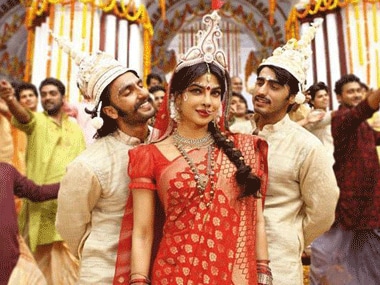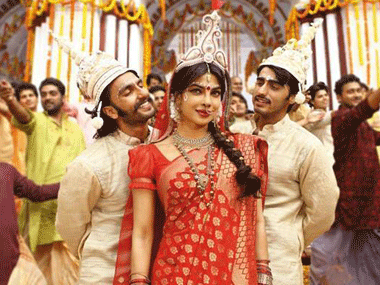When the trailer of Gunday hit the internet last month, the ripples were felt most powerfully in West Bengal. Not because Bengalis are particularly susceptible to Ranveer Singh’s gloriously bronzed pecs or because Priyanka Chopra wore an orange dhakai sari, but snatches of Howrah Bridge in the trailer and the stray shop signboards written in Bengali stoked more interest in the land of the bhodrolok than the usual non-Khan film from Yash Raj Films. Another surprise followed swiftly. There was a new trailer and in this, the all-brawn heroes and the simpering heroine were speaking in Bengali! Even the songs, from the peppy Entriyaan to the mushy numbers, were dubbed in Bengali. The dubbed version of Gunday will hit multiplexes and single screen theatres in Bengal alongside the original Hindi version. YRF told Firstpost that apart from the film and the promotional assets, Gunday’s Bengali soundtrack will be available online as will Bengali caller tunes from the film’s music. YRF has also launched a Bengali channel on YouTube called YRF Bengali. [caption id=“attachment_1386013” align=“alignleft” width=“380”]  Courtesy: Facebook[/caption] Talking to Firstpost, Rafiq Gangjee, vice president, marketing, at YRF wouldn’t confirm if the Mumbai-based studio would sustain this foray into the vernacular language film market. “For future films, that will depend largely on the creative need of the film and its setting,” he said. “Gunday is a story strongly seeped in the ethos and culture of Kolkata as the world knew it in the 1970s and 1980s and the turbulent time of that era.” That YRF is seriously trying to sink its teeth into the regional film market in India is evident from its web initiatives. Alongside the YRF Bengali channel, the house launched two other channels on YouTube, YRF Tamil and YRF Telugu. Last year, it released Dhoom:3 in Tamil and Telugu simultaneously with the Hindi version. Gangjee said of Dhoom:3, “It was the biggest release of a Hindi dubbed movie in the South, with almost 700 screens for the Telugu version and more than 100 screens for the Tamil version.” Trade analysts are of the opinion that the dubbed version was a hit. The path-breaker for Hindi films heading Southwards was Shah Rukh Khan’s Chennai Express, which broke box office records. According to film critic and trade analyst Sridhar Pillai, Chennai Express was the first ever Hindi film to have been dubbed and released in Tamil Nadu and it immediately cleared up space for Hindi films in the melee of Tamil blockbusters. Suburban audiences in Tamil Nadu, that usually avoid Hindi films, lapped it up. “The film’s dubbed version made nearly Rs 5 core in Tamil Nadu,” said Pillai. “A Hindi film usually makes not more than Rs 80 lakh to Rs 1 crore in Tamil Nadu. Everything about the film looked like a Tamil potboiler. The plot, most of the characters, the dances. No wonder it struck a chord with the viewers of Tamil language films.” YRF is taking careful, tentative steps into non-Hindi speaking India. While Dhoom:3 was released in Tamil and Telugu and did reasonably well in those sectors, it wasn’t dubbed in Bengali. Though nothing like Rohit Shetty’s Chennai Express, Dhoom:3 did have elements that Tamil and Telugu audiences expect in blockbusters - a larger than life hero, lots of high voltage action and the standard good-wins-over-evil template. “The South market has tremendous untapped potential for simultaneous releases in the respective dubbed versions and more and more films will start looking at it, and not just the tent-pole big budget films,” says Gangjee. Pillai pegs the Tamil film industry’s net worth at more than Rs 1,000 crore. “The industry makes at least 150 films a year and the big films are made with a budget of Rs 50 crore to 60 crore,” said Pillai. No wonder YRF is so keen to paddle in these waters. Apart from dubbing prospective blockbusters with big stars, YRF has also bought television spots in satellite channels and might also sell television broadcast rights of the dubbed versions. In fact, YRF will make its debut in the Tamil film industry with Aha Kalyanam, later this year. It will be a remake of their hit Band Baaja Baraat. The film stars Vaani Kapur in Anushka Sharma’s character. However, YRF’s move beyond Hindi-speaking India has fluttered some feathers. In Kolkata, Hindustan Times reported that the local industry came together to ‘protest’ against YRF’s move because they see it as threatening. “Reportedly, personalities from the Bengali film industry including Jeet, Dev, Parambrata Chattopadhyay, June, Payel Sarkar, Haranath Chakraborty, Aniruddha Roy Chowdhury and Srijit Mukherji — got together for two hours at the Bharat Lakshmi Studio to protest against the “disaster”. They were joined by Raj Chakraborty, Mahendra Soni, Shrikant Mohta, Ashok Dhanuka, Nispal Singh, Sudeshna Roy and several technicians,” reports HT. Their concern seems partially valid. Gunday’s trailer looks like the film will go down well with the rural audience in Bengal, which has shouldered the industry for decades until new production houses and corporate houses stepped in with investments in the 2000s. Gunday in Bengali, with its high-on-testosterone, high-on-adrenaline dialogues, the decidedly macho, buff heroes and the sultry heroine, is exactly what the Bengali suburban audience would love. Add to that superior production qualities, better technology and fancy styling, and the contest becomes unfair. Gunday, touted to be a mid-budget film was made with approximately Rs 30 crores. A big budget Bengali film is made with Rs 4-5 crores. The Economic Times reports that Srijit Mukherji’s Jatiswar (Rs 4 crore), Aniruddha Roy Chowdhury’s Buno Hash ( Rs 4.5 crore), Raja Chandra’s Bachchan ( Rs 5.5-6 crore) were all produced by Reliance Entertainment. _Gunday’_s budget is easily five times the budget of a ‘big’ Bengali film. Ravi Sharma of Shree Venkatesh Films, which is one of the major film producers in Bengal, doesn’t see Bollywood’s interest in Bengali cinema as a promising development. “I don’t see a point of releasing them in Bengali so that it percolates into the market that is exclusively for Bengali films,” said Sharma. “The [Bengali] industry, including all the actors, directors and producers are not going to support the move. We are trying to do good work and this will set a bad precedent. More and more Bollywood production houses might take to doing this, jeopardising the vernacular language industries.” The only stumbling block in YRF’s seeming expansion plans is the star-fan relationship that forms the bedrock of a film industry. Pillai points out that a Shah Rukh Khan or an Aamir Khan is not perceived to be a threat to stars down South. “It’s almost as if the viewers have made a separate niche for them. They are not perceived to be a threat to Surya in the Tamil film industry or Mahesh Babu in the Telugu industry,” says Pillai. The same, however, might not hold for the Bengali film industry. While local heroes like Dev and Jeet do have steady fan following, the revival of the popular Bengali film industry has hinged on directors like Raj Chakraborty remaking hit films from the south. The films that have bred the new tribe of stars were based on copies of titles like the Tamil Singham. The heroes are styled like Bollywood heroes. The music and lyrics are distinctly modelled upon Bollywood. Now imagine the audience of these films getting to see the original potboilers but without a language barrier. Will the entry of Bollywood hunks into Bengali cinema spell ‘the end’ for the current crop of heroes? Or will Bengal sneer at the north Indian hulks pretending to be Bengali? Watch this space.
Will the entry of Bollywood hunks into Bengali cinema spell ‘the end’ for the current crop of heroes? Or will Bengal sneer at the north Indian hulks pretending to be Bengali?
Advertisement
End of Article


)
)
)
)
)
)
)
)
)



